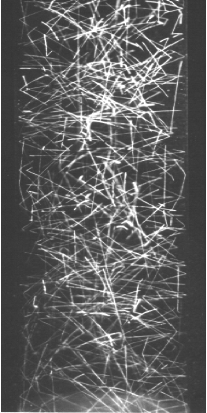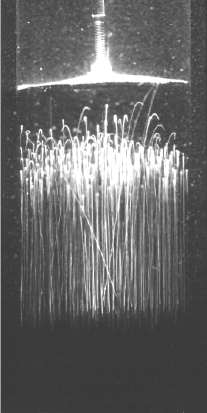 |
|
Due
to inelastic collisions between particles, granular
gases display striking properties compare to
molecular gases such as cluster formation, and
non-Gaussian velocity distribution.
Ground experiments:
- Spatially
homogeneous forcing:
Several
major differences with respect to thermodynamiclike
gas and boundary-forced dissipative granular gas:
(i) the equation of state displays strong analogy
with the usual gas one apart from a geometric factor
(container-particle aspect ratio), (ii) the particle
velocity distribution displays an exponential tail,
and (iii) no cluster formation occurs even at higher
density.
See movies in Equation of state of a granular gas homogeneously driven by particle rotations E. Falcon, J.-C. Bacri & C. Laroche EPL (Europhysics Letters) 103, 64004 (2013)
- Boundary forcing:
* Clustering formation, pressure
and density measurements E.
Falcon, S. Fauve & C. Laroche, European
Physical Journal B, 9, 183-186 (1999)
* An experimental study of a granular gas fluidized by vibration E. Falcon, C. Laroche & S. Fauve in "Granular Gases", Vol. 564 of Lectures Notes in Physics, T. Pöschel &S. Luding (Eds.), Springer, Berlin, p. 244-253 (2001)
Micro-gravity experiments:
* Collision statistics of a dilute granular gas in zero gravity. E. Falcon et al., Europhysics Letters 74, 830 (2006)
* Clustering formation in micro-gravity (see also here). E. Falcon et al., Physical Review Letters, 83, 440-444(1999)(For an overview on experiments of granular media in low-gravity)
Simulation of vibrated granular medium with impact - velocity - dependent - restitution coefficient
References:
S. McNamara & E. Falcon, Powder Technology 182, 232 (2008)
S. McNamara & E. Falcon, in “Granular Gas Dynamics”, Vol. 624, Lectures Notes in Physics, T. Pöschel & N. Brilliantov (Eds.), Springer, Berlin, p. 347-366 (2003)



